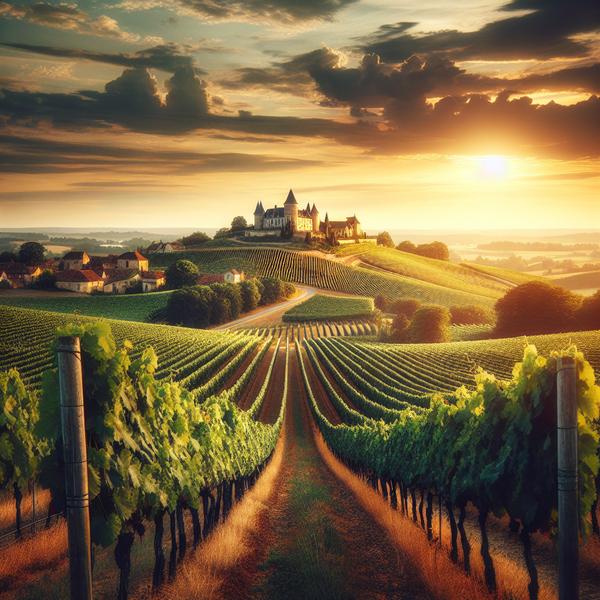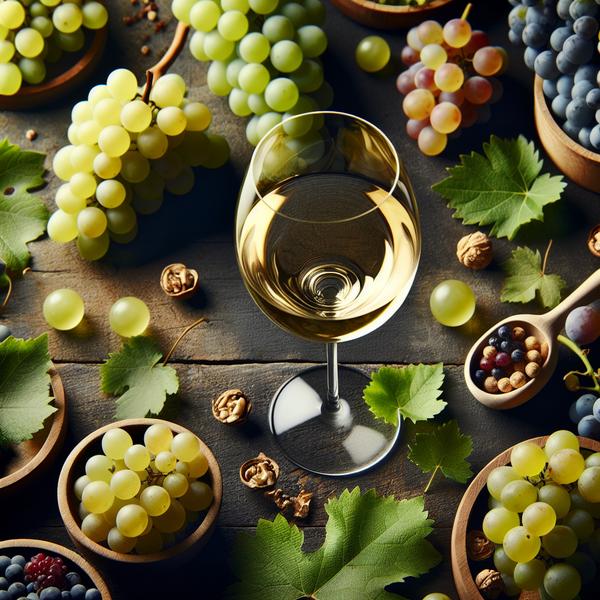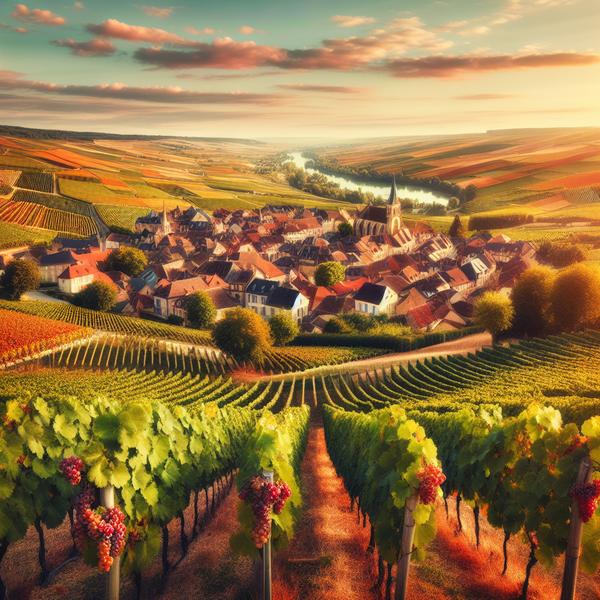The Ultimate Guide to French Grapes (Types, Wine & More)

Picture this:
You're standing in a charming French vineyard, a glass of velvety red wine in hand. 🍷
Your taste buds are tingling with anticipation, ready to embark on a journey through the rich tapestry of French grapes.
But where do you start?
Don't worry, I've got your back.
Let's uncork the secrets together and become bona fide experts in the world of French wine.
Buckle up, because we're about to embark on a tantalizing adventure.
Let's dive in.
Understanding the Importance of French Grapes in Wine Production
French grapes are vital for producing exceptional French wines, renowned for their unique flavors. Although European wine labels may not disclose the grape varieties used, the combination of these grapes with the region's climate and soil creates the distinct character that sets French wines apart.
French vineyards, known far and wide for making damn good wine, play a big part in giving French wine its distinct character.
To really get French wine, you gotta get into the different types of grapes they use.
Unlike other places that put the grape info on the label, European labels often leave it out.
But don't worry, that doesn't mean you can't savor French wines to the fullest.
In fact, part of the charm is teasing out all the hidden flavors and intricate blends.
As you explore French wines, you'll discover a whole range of grapes, each with their own special traits.
Let me break down some of the big ones for you:
Chardonnay grapes, famous for creating smooth and delicious white wines, thrive in the Burgundy region.
The tastes can vary from zesty citrus to tropical fruit vibes, depending on the winemaker's tricks.
Cabernet Sauvignon grapes, the MVP of Bordeaux blends, give you bold-bodied reds bursting with black fruit flavors and strong tannins.

They bring structure, depth, and longevity to the final blend.
Merlot grapes, another heavyweight in Bordeaux wines, bring rich plum and cherry flavors, as well as a touch of plushness.
It balances out the intensity of Cabernet Sauvignon and gives the blend a velvety texture.
Pinot Noir grapes, mainly grown in Burgundy, produce light and delicate reds.
They have an aroma that ranges from raspberry and cherry to earthy fragrances, showing off their finesse and elegance.
And then we come to the diva of French wines, Champagne.
This bubbly babe is made exclusively in the Champagne region, using Chardonnay, Pinot Noir, and Pinot Meunier grapes.
Every sip is a dazzling experience with its fizzy joy and complex flavors.
Knowing the importance and uniqueness of these French grapes helps you appreciate the special qualities in each wine. So, the next time you pop open a bottle of French wine, take a minute to think about the artistry behind it.
Each sip is a story woven from sun-kissed grapes and magic-infused terroir.
Main points I'll expand upon further down this article:
- Red wines from Burgundy, such as Beaujolais, are made from Gamay grapes.
- Merlot is the most popular red grape variety in France.
- Bordeaux is known for its red blends dominated by Cabernet Sauvignon.
- White Bordeaux is refreshing with its Sauvignon Blanc.
- Alsace offers distinct flavors of Gewürztraminer and Riesling.
- French wines are often labeled with controlled place names or appellations.
- Understanding the concept of 'terroir' is crucial in understanding French wines.
- Champagne undergoes a second fermentation in the bottle for carbonation.
- Languedoc and Roussillon focus on blends of Carignan, Cinsault, Grenache, Syrah, and Mourvèdre.
- French wines have distinct earthy and mineral flavors.
But what about the other red grape varietals that contribute to the rich tapestry of French wine?
Let's dive deeper into the unique characteristics of Gamay, Merlot, Cabernet Sauvignon, and Pinot Noir, uncovering the secrets of these beloved grapes...
Exploring the Distinctive Red Grape Varietals That Define French Wine
If you're interested in French wine, here's a list for you that highlights the distinctive red grape varietals:
- In Burgundy, Beaujolais is made from the Gamay grape.
- You'll find notable regions like Morgon and Fleurie that really show off the qualities of Gamay.
- As for favorites, Merlot stands out as a top choice.
- France also boasts noble grapes like Cabernet Sauvignon and Pinot Noir, which hold their own.
- Bordeaux, the second largest wine region, focuses on red blends where Cabernet Sauvignon takes the lead.
- These blends often have other grape varieties mixed in to add depth to the flavors.
- If you're looking for the best expression of Pinot Noir, you'll find it in Red Burgundy.
- Pinot Noir is known for its characteristics that perfectly represent the wines of this region.
But wait, there's more to explore!
While we've touched upon the red grape varietals that define French wine, let's now delve into the intriguing world of white grape varietals.
Are you ready to uncover the distinct flavors and aromas associated with popular grapes like Chardonnay, Chenin Blanc, Sauvignon Blanc, and Riesling?
Trust me, your taste buds are in for a treat as we journey through France's diverse vineyards.
Exploring the Key White Grape Varietals and Their Distinctive Flavors in France
Exploring the different white grape varietals in France is like a delicious treat for your taste buds! 😋

Let's break it down:
- Chardonnay, a beloved crowd-pleaser, offers you the smooth and rich taste of butter and cream. It's like sipping on a tropical fruit cocktail with hints of vanilla and even a touch of oak.
- When it comes to Sauvignon Blanc, get ready for a burst of refreshing flavor. With its vibrant acidity, you'll taste zesty citrus, crisp green apple, and a hint of freshly cut grass. It's perfect for quenching your thirst on a sunny summer day.
- Chenin Blanc is a real shape-shifter. From sweet honeyed goodness and delicate floral aromas to lively acidity and mineral notes, this grape surprises and delights with its many faces. You never know what adventure awaits with each sip.
- If you find yourself in Alsace, prepare to be enchanted by Gewürztraminer and Riesling. Gewürztraminer seduces with exotic spices and the irresistible fragrance of lychee. Meanwhile, Riesling puts on a show with its floral perfume and tangy acidity that keeps you coming back for more.
- In Bordeaux, White Bordeaux reigns supreme. It's like Sauvignon Blanc wearing a crown, offering a refreshing and invigorating character. Subtle herbal and citrus notes add an elegant touch to this regal wine.
- Down in the southern regions of France, Ugni Blanc steals the spotlight. It brings a delightful medley of flavors to the stage, including juicy apples, ripe pears, and just a hint of melon.
These French white grapes are a treasure trove of exciting flavors that any wine enthusiast or adventure seeker will absolutely adore.
And before I forget, I have something else for you.
If you're feeling adventurous and want to dive deeper into the world of French delicacies, you absolutely must check out my guide Camembert vs Brie.
The Influence of French Grape Varietals on Regional Wine Styles
French regional wine styles are shaped by the influence of different grape varietals. In Bordeaux, Cabernet Sauvignon dominates on the Left Bank, while Merlot takes center stage on the Right Bank.
Bordeaux wines have a reputation for their complex blends.
Cabernet Sauvignon brings in the structure and intensity, while Merlot adds a softer and fruitier touch.
In Alsace, they like to be specific on the label and mention the grape varieties used.
The stars of the show in Alsace are Gewürztraminer, Riesling, Pinot Gris,and Pinot Blanc.
These grapes give us aromatic whites with vibrant acidity and distinct flavors.
Now let's move to the Loire Valley. Here we find a wide range of grapes that create different styles of wine.
You have Sauvignon Blanc, which gives us crisp and herbaceous whites.
Then there's Chenin Blanc, showing off its versatility in both dry and sweet wines.
Cabernet Franc provides light-bodied yet flavorful reds, and Pinot Noir charms us with its elegance and delicacy.
But when it comes to Burgundy, it's all about Chardonnay and Pinot Noir.
These two reign supreme here.
Chablis, one of the subregions of Burgundy, produces bone-dry whites with flinty minerality.
And the Cote d'Or?
Well, that conjures up images of rich and velvety reds alongside elegant whites.
Let's head south now to the Rhône Valley.

Here, GSM blends steal the spotlight.
Grenache, Syrah, and Mourvèdre come together to create bold, spicy, and full-bodied wines.
In the northern part of the region, Syrah takes center stage alone, producing powerful and intense wines.
Ah, Provence!
When you think of Provence, you think of dry rosé wines.
They are famous for their pale pink color, refreshing acidity, and delicate aromas.
Perfect for those warm summer days and outdoor gatherings.
Now, I know you might be wondering how all these French wines differ from those produced in America.
Well, let me tell you.
French wines carry the weight of history and tradition.
They come from old world regions with winemaking techniques that have been passed down through generations.
On the other hand, American wines come from new world countries that prioritize innovation and experimentation.
Understanding these differences will help you appreciate and navigate the world of French wine.
So grab a glass, explore different grape varietals, and immerse yourself in the diverse flavors and styles that French winemaking has to offer.
The journey is waiting for you!
Exploring the Connection Between French Grape Varietals and Their Terroir
Terroir, an elegant French term that describes the enchanting bond between grapes and their surroundings, is crucial for grasping French wines. You know, the type of soil, altitude, climate, and weather all contribute to shaping a wine's character.
Take Champagne, for example.
This luxurious sparkling beverage stands out due to its traditional method that involves a second fermentation in the bottle.
That's what gives it that heavenly fizz you adore.
And let me tell you about those marvelous chalky soils!
Now, when it comes to the coastal areas of Languedoc and Roussillon, their focus lies on crafting exquisite red and rosé wines.
They take fancy names like Carignan, Cinsault, Grenache, Syrah, and Mourvèdre, blend them together, and produce bottles that make your taste buds dance with joy.
Tasting these wines will have your taste buds dancing, just you wait and see!
Now, allow me to introduce you to Beaujolais.
This divine place, nestled within the Rhône Valley, has a little secret of its own.
They are all about Gamay grapes.
Yep, that's right.
These grapes breathe life into wines bursting with fruity flavors and refreshingly lively acidity.
Now, let's head down south to Provence, where they certainly know how to craft pale rosé wines.
And which grapes do they rely on, you might wonder?
Well, it's mainly Grenache, Cinsault, and Syrah.
But hold on tight, my friend.
When we delve into old world wines like those from France, we simply can't ignore Bordeaux and Burgundy.
You see, Merlot grapes thrive splendidly along the right bank of the Gironde River in Bordeaux.
Meanwhile, over in Burgundy, things can become a bit unpredictable and expensive, but boy oh boy, their wines are worth every single penny.
And let's not overlook Chateauneuf-du-Pape, a legendary blend from the southern Rhone region. It's like a symphony of grapes converging to create an unforgettable moment.
But what about the characteristics of these French grape varietals?
Let's dive in and discover how tannin levels, acidity, fruit profiles, and aging potential shape the renowned taste of French wines!
Characteristics of French Grape Varietals and Their Influence on Wine
| Grape Varietal | Characteristics |
|---|---|
| Cabernet Sauvignon | Known for its rich tannins and full body. |
| Merlot | Produces smooth and supple wines. |
| Pinot Noir | Exhibits delicate and complex flavors. |
| Syrah | Offers bold flavors and medium to full body. |
| Chardonnay | Known for its versatility and buttery notes. |
| Sauvignon Blanc | Delivers refreshing acidity and herbal aromas. |
| Gamay | Produces light-bodied and fruity wines. |
| Chenin Blanc | Showcases a range of flavors from dry to sweet. |
| Grenache | Known for its fruity and spicy character. |
| Mourvèdre | Adds depth and complexity to blends. |
French grape varietals are key players in the captivating world of wine.
They boast remarkable characteristics that set them apart from the rest.
Let's talk tannin levels, Wheter you're a seasoned sommelier or an aspiring connoisseur, you know that tannins are impactful. French grapes offer varying levels of this compound.
Some, like Cabernet Sauvignon, pack a mighty punch with robust tannins that give your taste buds a wake-up call.
On the flip side, grapes like Pinot Noir showcase lighter tannins for a smoother sip.
Next up, acidity!
It brings life to the party.
French grapes dazzle with bright acidity that keeps your palate dancing. From the citrusy notes of Sauvignon Blanc to the zingy flavors of Gamay, these grapes make every glass sing.
But hold on, there's more...
Fruit profiles tell a story with each sip.
French grapes flaunt diverse fruit profiles, ranging from luscious berries in Merlot to zesty lemon in Chardonnay.
You name it, they've got it!
Can we talk earthy vibes?
Oh là là!
French grapes go beyond fruity goodness.
Get ready for hints of dirt, chalk, and mushrooms that infuse unparalleled character into every drop. It's like sipping elegance.
One last thing – have you heard of Bordeau blends?
These gems combine different French grape varietals into euphoric harmony.
Unlike wines from the new world, they enthrall with lighter, yet sophisticated profiles.
A flavor journey like no other.
Bottom line: French grape varietals bewitch with their distinct flavors and delightful nuances. Let your taste buds embark on this remarkable adventure.
Enhancing Your Wine Tasting Experience: Unlocking the Unique Characteristics of French Grape Varietals
Developing a discerning palate for French grape varietals
So, you want to take your wine tasting experience up a notch and truly appreciate the unique flavors of French grape varietals?
Well, let me show you how.
Understanding the diverse range of flavors and aromas
To fully unlock the potential of French wines, you need to grasp the different grape varieties that give them their distinct tastes and smells.
Take Chardonnay, for instance.
It has this amazing rich, buttery flavor that reminds you of tropical fruits like pineapple and mango.
And if you prefer something with crisp acidity, Sauvignon Blanc offers hints of citrus and green herbs that keep your taste buds intrigued.
And we can't forget about red wines!
Bold and full-bodied, Cabernet Sauvignon bursts with flavors of blackberry, black currant, and just a touch of spice. On the other hand, Pinot Noir is known for its elegance and finesse, boasting delicate cherry and strawberry flavors with earthy undertones that sweep you off your feet.
Price doesn't always reflect quality
Here's a little secret: the price tag on a bottle of French wine doesn't always indicate its true quality.
So, don't feel that you need to spend a fortune to enjoy an incredible wine tasting experience. There are hidden gems out there waiting to be discovered at wallet-friendly prices.
By exploring the vast array of flavors and aromas offered by French grape varietals, you can confidently find exceptional wines without breaking the bank.
Trust your own palate and let it guide you as you delve into the enchanting world of French wines.
Note: If you're curious about what cornichons are and what they taste like, check out my article on Understanding Cornichons. Trust me, you don't want to miss out on discovering the delightful flavors these tiny pickles have to offer.
Lesser-Known French Grape Varietals Worth Discovering
Expand your wine horizons by exploring lesser-known French grape varietals.
Gros Manseng, Picpoul, Malbec (Côt), and Jacquère are hidden gems that deserve your attention.
But let's not forget the Jura valley, a haven for natural wine lovers.
In this picturesque region, you can experience the unique Savagnin grape that creates Jurassien Vin Jaune - an extraordinary delight for wine enthusiasts like yourself.
So, step off the beaten path and discover the wonders of these lesser-known varietals, expanding your palate and thrilling your taste buds with their distinct flavors.
And that's all for today folks.
Before you leave, can I ask you something? Did my blog post prove useful for you? If it did, I would greatly appreciate it if you could share it with your friends and family. We've made it super easy to do so by including social media sharing icons. Your support means a lot to me. Thanks in advance!
Until next time,
-Bianca Rossi